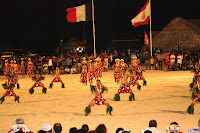The navigational charts were accurate for Suwarrow and we gratefully slipped into the calm anchorage and dropped the hook with 8 other boats. What a great place this is. Several of the boats have kids, so Emily is happy too. While cleaning up the boat after the passage, the captain found a small Gecko clinging to the side of a fender. Apparently he had stowed away and spent the last 5 days outside hanging on. Since Emily had been begging to have a gecko on the boat (they eat flies and small bugs too) and this guy had already survived being at sea, I relented and it now lives aboard Emily Grace ...somewhere.
 |
| Our Stowaway |
This isolated and uninhabited atoll in the Northern Cook Islands (located at 13°15'S, 163°06'W) has been for many years a favourite destination among sailors cruising the South Pacific. The man who put Suwarrow on the international cruising map was a New Zealander, Tom Neale, who, in the 1960s, lived on the atoll for six years. He described his Robinson Crusoe adventures in a book "An Island to Oneself" which inspired many sailors to visit this unique place. Tom Neale died in 1977, but inspired by his experience, the Cook Islands government declared Suwarrow a national park. Suwarrow is a major breeding ground for thousands of birds.
 |
| This Motu was where we hunted for crabs and had lunch |
 |
| Baby Booby close enough to touch |
Nowadays it's a popular spot for cruisers coming from Bora Bora, 680 miles away to the southeast. From Suwarrow to US Samoa is another 480 miles. The park ranger, James and his assistant, Appii (rhymes with Happy) could not have been nicer. There is a $50 dollar park fee, but compared to the high fees in the Southern Cooks and their confiscation of all Non-New Zealand meat, it was a bargain. Almost every day, they would take a group, spear fishing, snorkelling, scuba diving or fishing to several of the other atolls. James explained his interpretation of the Cook Island rules to us this way. Your frozen meat, beer and wine must also be confiscated here. However, rather than my taking it all at once, meat must be brought ashore each night and "burned" on their grill (and consumed) and spirits poured out slowly (into glasses). We can handle that interpretation!
The day we arrived, a group had gone "hunting" for Coconut crabs and a snorkel. They returned with a large sack of crabs and several fish they had caught while trolling along the way. The sea life here is abundant since it is so remote. The coconut crabs are land creatures and climb the trees and pick the coconuts from the tree. After they fall it can take them almost 1 week to peel away the husk and crack into the sweet meat. This diet gives their meat a little coconut flavour and it is quite good. The nine crews and rangers ate their fill and there was enough meat left over to make crab cakes the next day and feed everyone again.
 |
| Coconut Crab in the wild |
 |
| James cooking on his custom grill |
 |
| Nice Presentation by the Rangers-Enough for the whole anchorage! |
 |
| The Suwarrow Yacht Club |
 |
| Feeding black tip sharks the dinner scraps |
Several of the guys had spear guns and it was exiting to watch them descend 30 to 40 feet while holding their breath for the attack. The added complication to spear fishing here are the sharks. There are numerous sharks inhabiting the lagoon and anchorage. The black-tipped sharks are little threat, but white-tipped and grey sharks are much more aggressive. After they spear the fish, it is a race to the surface since the bleeding, thrashing fish quickly brings in the sharks. The diver tries to hold the fish (still on the spear) out of the water while swimming back to the anchored dingy to drop off the fish. Off course, you can imagine the fish blood running down the hunters arm. My job, as a non-spear guy, was to watch and whack at the attacking sharks to discourage any loss of body parts.what fun! We got several grouper and parrot fish and headed back to the anchorage for yet another feast.
We have been here almost a week and are looking for a calm weather period for the 3-day trip to American Samoa. Cruising without a schedule is helpful. We have seen several boats head into really rough weather just to be somewhere at a pre-arranged time to pick up or drop off guests. It looks like strong winds and waves for the next 3 days, so we may be stuck in this paradise for a little while longer.
Tom
Posted via SSB






























